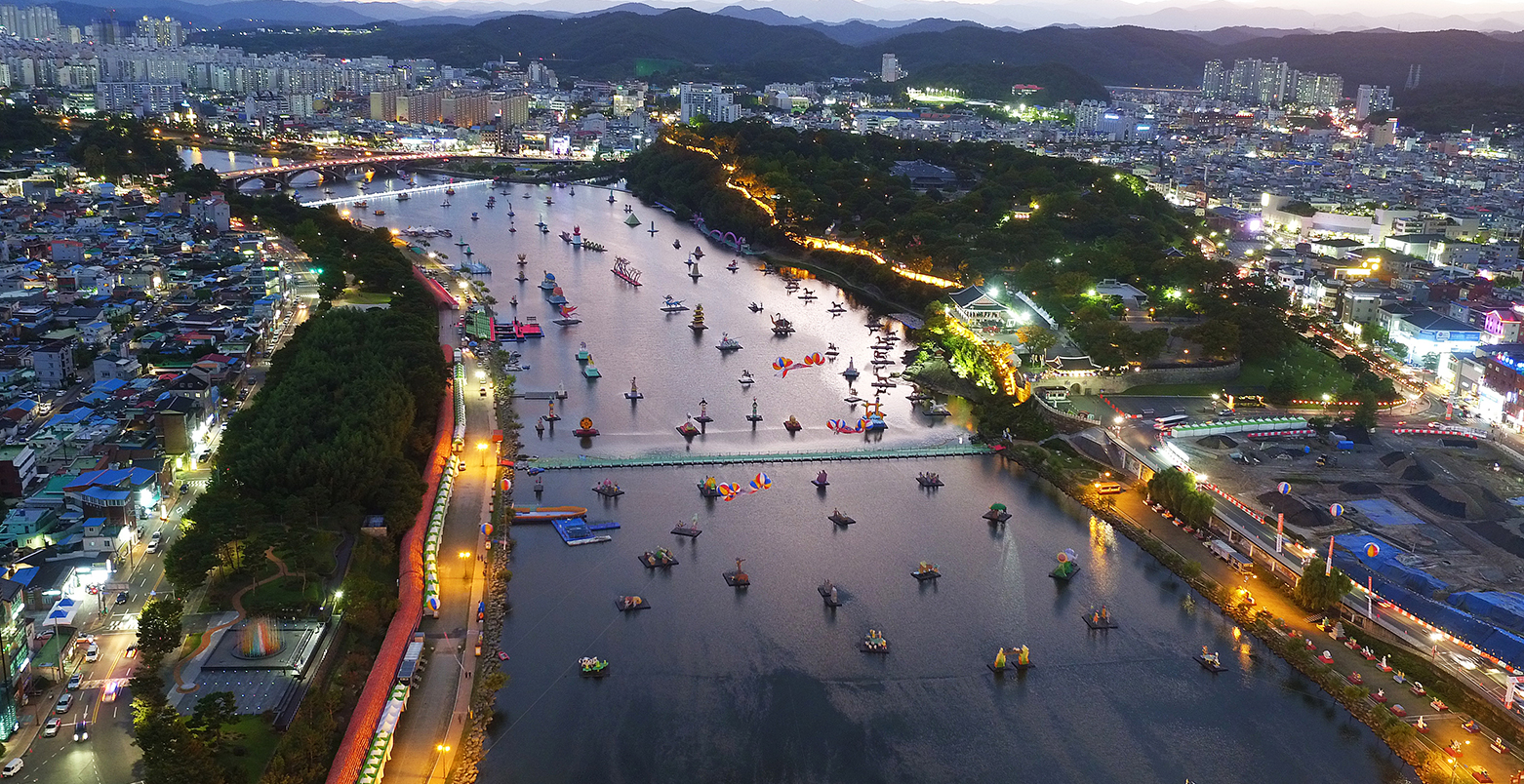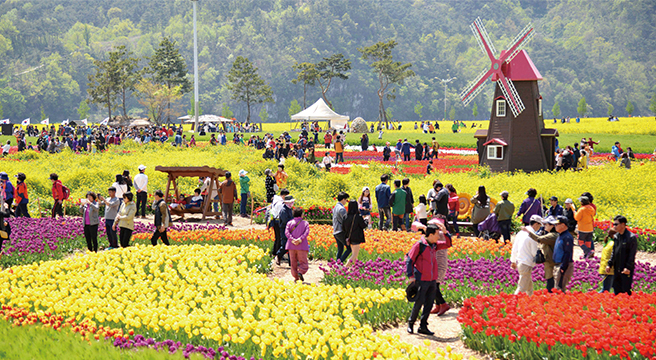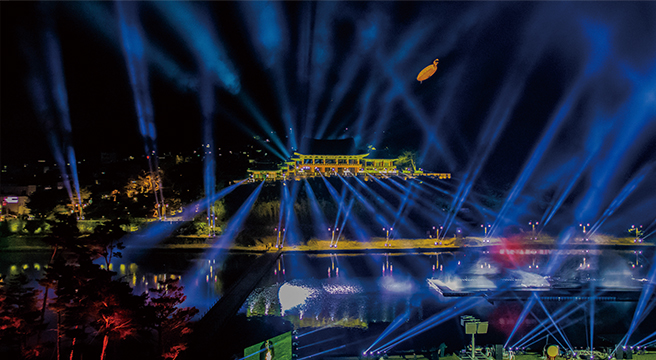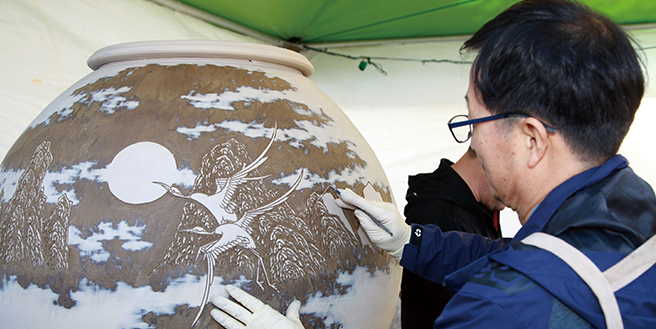
Contents










Spotlight · Written by Kim Samuel
Intriguingly Illuminating
Jinju Namgang Yudeung Festival
Every October, beautiful lamps decorate the Namgang River in Jinju, Gyeongsangnam-do Province.
A variety of performances are held at traditional markets, underground shopping centers and the old city center.
City residents commemorate the past spanning hundreds of years and pray for peace together through the lighting of lanterns throughout Jinju.

Reenactment of History
In October 1592, when the country was in chaos amid the first Japanese invasion and occupation of Korea, the 3,800-strong Joseon (Korean) army fought 20,000 Japanese forces for 10 days at Jinjuseong Fortress in the southern region of the Korean Peninsula. The history made on that day, namely flying sky lanterns over the city wall and floating lamps on the river to fend off foes sneaking across the Namgang River that flows under the fortress, lights up the night by the riverside even today, more than 400 years later.
Praying for Peace
The lamps lighting up the city are dedicated to those who gave their lives defending the country and their families and represent prayers for the happiness and peace of visitors to both the city and the festival. More than 70,000 lamps are hanged, launched and flown to wish comfort until dawn. Thus Jinju in October bursts with over a million visitors each year.
More about Jinju Namgang Yudeung Festival ⟶
Gyeongsangnam-do Province:
Full of Fascinating Festivals


© Changnyeong-gun
Changnyeong Nakdonggang Youchae Festival
/ April 11-14
The Nakdonggang River Canola Flower Complex in Changnyeong-gun County is the country’s largest garden of its kind, covering over a square km. The river, in combination with canola flowers, creates a beauty reminiscent of a landscape painting. Commenced in 2006, the festival is now the region’s premier festival with more than a million visitors.
The festival area stretches beyond the flower garden to the path of a cliff and the skies themselves. The Namji Gaebiri-gil trail, which was formed on the side of the towering cliff along the river, is so narrow that only one person can pass through at a time. Yet, the dazzling landscape seen from the cliff tens of meters high is a rare spectacle. And the air show performed by the Black Eagles, the demonstration team of the Korean Air Force, emblazons the unfolded sky over the extensive flower garden.
More about Changnyeong Nakdonggang Youchae Festival ⟶


© Miryang City
Miryang Arirang Festival
/ May 18-21
“Miryang Arirang,” a version of the classic folk song “Arirang” and the tune’s edition representing the Gyeongsang-do region, remains popular to this day due to its memorable lyrics and vigorous and cheerful rhythm. Once a military tune with alternate lyrics sung by independence fighters during the Japanese colonial era, the song is the soul of the region’s leading festival, which marks its 61st edition this year.
The Miryang River Odyssey is the festival program drawing the biggest applause. An mateur cast of nearly 1,000 members have appeared in multimedia performances against the backdrop of Yeongnamnu Pavilion and the Miryanggang River, whose magnificent views are awe inspiring. Running from Oct. 3-5, the festival will feature both the timeless folk song and a feast of lights by the riverside.
More about Miryang Arirang Festival ⟶


© Namhae-gun
Oktoberfest at Namhae German Village
/ October 3-5
A unique village that resembles something straight out of Germany was built by Koreans who worked in the European country in the 1960s as nurses and miners to earn foreign currency for Korea and returned home around 2000. The Korean-Germans, now spending their silver years in their motherland, have devoted themselves to recreating German culture and environment in the village, which has emerged as a popular tourist spot with exotic houses and scenery. Since 2010, the village has hosted a beer festival that attracted more than 100,000 visitors last year. A variety of colorful attractions and food, ranging from a welcoming parade and ceremony to German beer and delicious sausages, is offered.
More about Namhae German Village ⟶


© Gimhae City
Gimhae Buncheong Ceramics Festival
/ Oct. 25-Nov. 3
Now in its 24th year, the festival is the brainchild of 120 domestic artists who seek to pass down and develop the history and excellence of Gimhae’s pottery, which dates back 2,000 years and is descended from Gaya’s earthenware in the Iron Age, as well as promote the Korean ceramics industry.
The festival features high-end exhibitions such as a comparative display of Buncheong ceramics, white porcelain and celadon, and around 10 interactive events including a potter’s spinning wheel and “mud stacking,” as well as a demonstration of large-sized pottery. Other events feature Buncheong ceramics coupled with cooking, flowers and coffee. And the unusual scene of nearly 1,000 people making pottery occurs at the yard at the family pottery-making event. Visitors can also take home their ceramic creations.
More about Gimhae Buncheong Ceramics Festival ⟶
Other Articles















